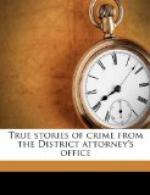Of course, if there was anybody by the name of Hubert who actually owned the property, and Browne had signed his name, conveying the same, to a deed to Levitan, Browne was guilty of forgery in the first degree. But the evidence in the case pointed toward the conclusion that Browne himself was Hubert. If this was so, how could Browne be said to have forged the name of Hubert, when he had a perfect legal right to take the property under any name he chose to assume? This was incontestable. If your name be Richard Roe you may purchase land and receive title thereto under the name of John Doe, and convey it under that name without violating the law. This as a general proposition is true so long as the taking of a fictitious name is for an honest purpose and not tainted with fraud. The Assistant District Attorney felt that the very strength of his case created, as it were, a sort of “legal weakness,” for the more evidence he should put in against Browne, the clearer it would become that Hubert was merely Browne himself, and this would necessitate additional proof that Browne had taken the property in the name of Hubert for purposes of fraud, which could only be established by going into the whole history of the property. Of course, if Browne were so foolish as to put in the defence that Hubert really existed, the case would be plain sailing. If, however, Browne was as astute as the District Attorney believed him to be, he might boldly admit that there was no Hubert except himself, and that in taking title to the property and disposing thereof under that name, he was committing no violation of law for which he could be prosecuted.
The case was moved for trial on the twelfth of March, 1906, before Judge Warren W. Foster, in Part Three of the Court of General Sessions in New York. The defendant was arraigned at the bar without counsel, owing to the absence of his lawyer through sickness, and Mr. Lewis Stuyvesant Chanler, the later Lieutenant-Governor of the State, was assigned to defend him. At this juncture Browne arose and addressed the Court. In the most deferential and conciliatory manner he urged that he was entitled to an adjournment until such time as he could produce William R. Hubert as a witness; stating that, although the latter had been in town on December 14th, and had personally given him the deeds in question, which he had handed to Levitan, Hubert’s interests in the West had immediately called him from the city, and that he was then in Goldfields, Nevada; that since he had been in the Tombs he, Browne, had been in correspondence with a gentleman by the name of Alfred Skeels, of the Teller House, Central City, Colorado, from whom he had received a letter within the week to the effect that Hubert had arranged to start immediately for New York, for the purpose of testifying as a witness for the defence. The prosecutor thereupon demanded the production of this letter from the alleged Skeels, and Browne was compelled to state that he had immediately destroyed it on its receipt. The prosecutor then argued that under those circumstances, and in view of the fact that the People’s evidence showed conclusively that no such person as Hubert existed, there was no reason why the trial should not proceed then and there. The Court thereupon ruled that the case should go on.




